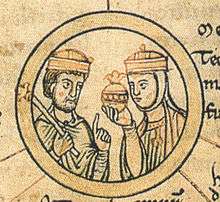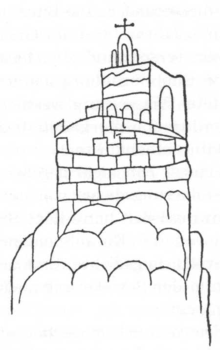Matilda of Ringelheim
| Saint Matilda | |
|---|---|
 Heinricus rex and Methildis regina, Chronica St. Pantaleonis, 12th century | |
| German queen | |
| Born |
c. 894/97 Enger, Saxony, East Francia |
| Died |
14 March 968 Quedlinburg, Saxony, Holy Roman Empire |
| Venerated in |
Eastern Orthodox Church Roman Catholic Church |
| Canonized | (Possibly by acclamation) |
| Major shrine | Quedlinburg Abbey, Saxony-Anhalt, Germany |
Saint Matilda (German: Mathilde von Ringelheim; c. 894/97 – 14 March 968) was Duchess of Saxony from 912 and German queen (Queen of the Franks) from 919 by her marriage with Henry the Fowler, the first ruler of the Ottonian dynasty. Upon her husband's death in 936, she founded Quedlinburg Abbey to commemorate the late king. Matilda lived to see Western Imperial rule restored when her eldest son Otto was crowned Holy Roman Emperor in 962. Her surname refers to Ringelheim, where her comital Immedinger relatives established a nunnery about 940.
Biography
The details of St. Matilda's life come primarily from brief mentions in the Res gestae saxonicae by the monastic historian Widukind of Corvey (c. 925 – 973), and from two sacred biographies: the Vita antiquior, circa 974, and Vita posterior, circa 1003.
Matilda was born circa 895 in Enger, in the Westphalian part of the German stem duchy of Saxony. She was the daughter of Dietrich, Count in Westphalia, and his wife Reinhild,[1] a woman of Danish and Frisian descent.[2] Matilda's biographers traced her ancestry back to the legendary Saxon leader Widukind (c. 730–807). Her sister Frederuna married Count Wichmann the Elder, a member of the House of Billung.
As a young girl she was sent to Herford Abbey,[3] where her grandmother Matilda was abbess and where her reputation for beauty and virtue –and possibly also her extensive Westphalian dowry– is said to have attracted the attention of the Saxon duke Otto the Illustrious, who betrothed her to his son and heir, Henry, about 20 years her senior. By the conjugal union, the Ottonian dynasty (Liudolfings) considerably enlarged their possessions in western Saxony. Henry's previous marriage with Hatheburg of Merseburg was annulled.[4] They were married at the Pfalz of Wallhausen in 909 or 913.[5]
As the eldest surviving son, Henry succeeded his father as Duke of Saxony in 912 and upon the death of King Conrad I was elected King of East Francia (later Germany) in 919. He and Matilda had three sons and two daughters:
- Hedwig (910 – 965), wife of the West Frankish duke Hugh the Great, mother of King Hugh Capet of France
- Otto (912 – 973), Duke of Saxony, King of Germany from 936, and Holy Roman Emperor from 962
- Gerberga (913 – 984), wife of (1) Duke Giselbert of Lorraine and (2) King Louis IV of France
- Henry (919/21 – 955), Duke of Bavaria from 948
- St. Bruno the Great (925 – 965), Archbishop of Cologne and Duke of Lorraine

After her husband died in 936 at Memleben, Matilda and her son, now King Otto of East Francia, established Quedlinburg Abbey[3] in Quedlinburg, Saxony, East Francia, in present-day Quedlinburg, Saxony-Anhalt, Germany, in Henry's memory. Quedlinburg Abbey was a convent of noble canonesses, where her granddaughter, also named Matilda, became the first abbess in 966. At first the Queen Mother remained at the court of her son. During quarrels between the young king and his rivaling brother, Henry a cabal of royal advisors is reported to have accused her of decreasing the royal treasury in order to pay for her charitable activities. After a brief exile at her Westphalian manors in Enger, where she established a college of canons in 947, Matilda was brought back to court at the urging of King Otto's first wife, the Anglo-Saxon princess Edith of Wessex.
Matilda died on 14 March 968 in Quedlinburg Abbey, Quedlinburg, Saxony, East Francia, Holy Roman Empire, in present-day Quedlinburg, Saxony-Anhalt, Germany,[6] outliving her husband by 32 years, and having seen the restoration of the Holy Roman Empire. Her and Henry's mortal remains are buried in the crypt of St. Servatius Church within Quedlinburg Abbey.
Veneration
Saint Matilda was celebrated for her devotion to prayer and almsgiving. Her first biographer depicted her (in a passage attributed to the sixth-century vita of the Frankish queen Radegund by Venantius Fortunatus) leaving her husband's side in the middle of the night and sneaking off to church to pray. St. Matilda founded many religious institutions, including the canonry of Quedlinburg, which became a center of ecclesiastical and secular life in Germany under the rule of the Ottonian dynasty. She also founded the convents of St. Wigbert in Quedlinburg, in Pöhlde, Enger, and Nordhausen in Thuringia, likely the source of at least one of her vitae.
She was later canonized, with her cult largely confined to Saxony and Bavaria. St. Matilda's feast day according to the regional German calendar of saints is 14 March. There is a stained glass window dedicated to Saint Matilda in the parish church (built 1842) of Coole, County Westmeath in the Republic of Ireland.
Sources
- ↑ "Saint Matilda of Saxony", Saints.SQPN.com, 17 February 2014
- ↑ Rev. Baring-Gould, Sabine (1914). The lives of the saints. Edinburgh: John Grant. p. 260.
- 1 2 Sanctity and Power: The Dual Pursuit of Early Medieval Women, Suzanne F. Wemple, Becoming Visible: Women in European History, ed. Renate Bridenthal, Claudia Koonz and Susan Stuard, (Houghton Mifflin Company, 1987), 139.
- ↑ "Saint Matilda of Saxony", Saints.SQPN.com, 17 February 2014
- ↑ "Saint Matilda of Saxony", Saints.SQPN.com, 17 February 2014
- ↑ "St. Matilda", Catholic Online
Primary sources
- Widukind, Res gestae Saxonicae, ed. Paul Hirsch and H.-E. Lohmann, Die Sachsengeschichte des Widukind von Korvei. MGH SS rer. Germ. in usum scholarum 60. Hanover, 1935. Available online from the Digital Monumenta Germaniae Historica
- Vita Mathildis reginae antiquior (c. 974, written for her grandson Otto II), ed. Bernd Schütte. Die Lebensbeschreibungen der Königin Mathilde. MGH SS rer. Germ. in usum scholarum 66. Hanover, 1994. 107-142. Available from the Digital MGH; ed. Rudolf Koepke. MGH SS 10. 573-82; tr. in Sean Gilsdorf, Queenship and Sanctity, 71-87.
- Vita Mathildis reginae posterior (c. 1003, written for her great-grandson Henry II), ed. Bernd Schütte. Die Lebensbeschreibungen der Königin Mathilde. MGH SS rer. Germ. in usum scholarum 66. Hanover, 1994. 143-202. Available from the Digital MGH; ed. Georg Pertz. MGH SS 4: 282-302; tr. in Sean Gilsdorf, Queenship and Sanctity, 88-127.
Secondary sources
- Corbet, Patrick. Les saints ottoniens. Sainteté dynastique, sainteté royale et sainteté féminine autour de l'an mil. Thorbecke, 1986. Description (external link)
- Gilsdorf, Sean. Queenship and Sanctity: The Lives of Mathilda and the Epitaph of Adelheid. Catholic University of America Press, 2004. Description (external link)
- Glocker, Winfrid. Die Verwandten der Ottonen und ihre Bedeutung in der Politik. Böhlau Verlag, 1989. 7-18.
- Schmid, Karl. "Die Nachfahren Widukinds," Deutsches Archiv für Erforschung des Mittelalters 20 (1964): 1-47.
- Schütte, Bernd . Untersuchungen zu den Lebensbeschreibungen der Königin Mathilde. MGH Studien und Texte 9. Hanover, 1994. ISBN 3-7752-5409-9.
 Herbermann, Charles, ed. (1913). "St. Matilda". Catholic Encyclopedia. New York: Robert Appleton Company.
Herbermann, Charles, ed. (1913). "St. Matilda". Catholic Encyclopedia. New York: Robert Appleton Company.
Further reading
| Wikimedia Commons has media related to Matilda of Ringelheim. |
- Schlenker, Gerlinde. Königin Mathilde, Gemahlin Heinrichs I (895/96-968). Aschersleben, 2001.
- Stinehart, Anne C. "Renowned Queen Mother Mathilda:" Ideals and Realities of Ottonian Queenship in the Vitae Mathildis reginae (Mathilda of Saxony, 895?-968)." Essays in history 40 (1998). Available online
| Matilda of Ringelheim Born: c. 894/97 Died: 968 | ||
| Preceded by Hedwiga of Franconia |
Duchess consort of Saxony 912–936 |
Succeeded by Edith of Wessex |
| Preceded by Cunigunde of Swabia |
German Queen 919–936 | |